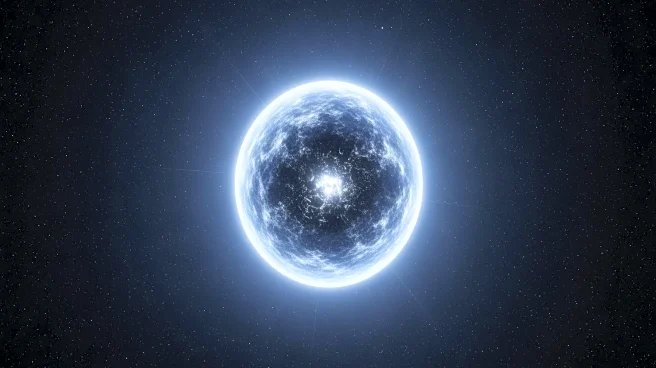What's Happening?
Researchers at INFN-Pisa and the University of Pisa have conducted a study on how asymmetric dark matter (ADM) might influence electron-capture supernovae (ECSNe) and the formation of neutron stars. ECSNe occur in stars with masses around 8-10 times that
of the sun, leading to supernova explosions and neutron star formation. The study presents the first self-consistent stellar-structure model of ADM's contribution to this process. The researchers used a general relativistic two-fluid formalism to explore the impact of dark matter on the collapse of ECSN progenitor cores and the subsequent explosion. Their findings suggest that dark matter can compress white-dwarf-like cores enough to trigger collapse at lower masses, leading to weaker explosions and unusually low-mass neutron stars.
Why It's Important?
This research provides new insights into the role of dark matter in stellar processes, potentially offering indirect signatures of dark matter at work inside stars. The study's findings could inform astrophysical studies focusing on ECSNe and future dark matter searches. Understanding how dark matter influences stellar explosions could lead to new approaches in probing dark matter properties, offering an astrophysical window into one of physics' biggest mysteries. The ability to form unusually light neutron stars could challenge conventional models and lead to a reevaluation of existing theories.
What's Next?
The researchers plan to improve their stellar model by including more realistic white dwarf compositions and considering a wider range of dark matter properties. They aim to investigate how different amounts of dark matter could leave observable fingerprints, such as unusually faint supernovae or very light neutron stars. Future studies may connect theoretical work with multi-messenger astronomy, using data from telescopes and gravitational-wave detectors to test dark matter's influence on stars.
Beyond the Headlines
The study highlights the potential for stellar explosions to serve as natural laboratories for probing dark matter properties. It underscores the importance of interdisciplinary approaches in solving complex cosmic mysteries and could influence future research directions in astrophysics. The findings may lead to a reevaluation of existing theories and models, offering new insights into the Universe's composition and the forces governing it.















